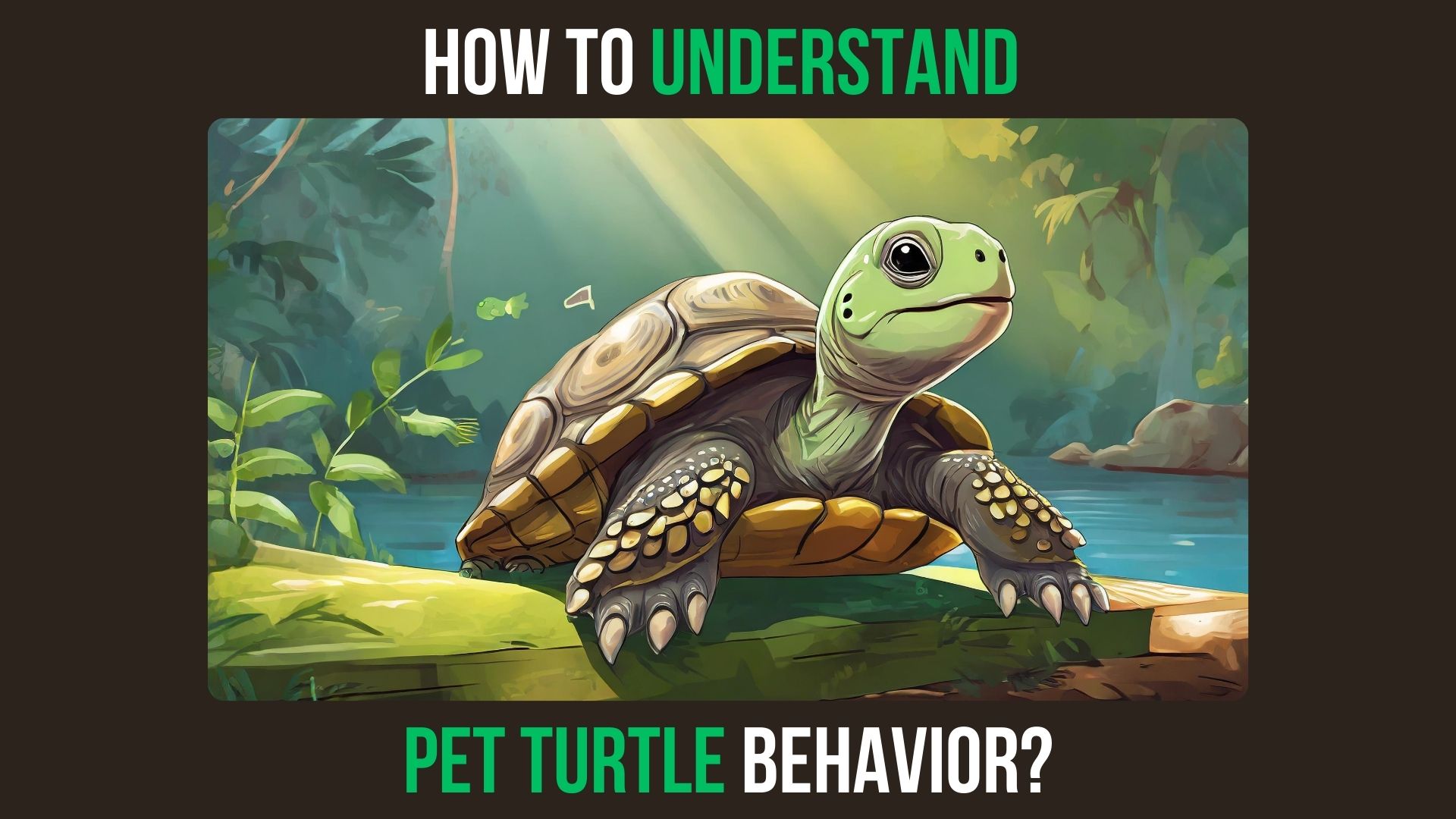Understanding pet turtle behavior is crucial for their overall well-being. Observing their actions can provide insight into their needs and health.
As reptiles, turtles are known for their docile nature and tendency to move at a slow pace, but there is more to their behavior than meets the eye. From basking in the sun to hiding in their shells, pet turtles carry out a variety of actions that can signify their current state and needs.
As a pet owner, it is essential to interpret and understand their behavior to ensure you are providing them with the care they require. In this article, we will discuss how to interpret and understand pet turtle behavior to keep your beloved pet healthy and happy.

Understanding The Language Of Turtles
Pet turtles are fascinating creatures that make great companions. They may not be as expressive as dogs or cats, but turtles do have their own language. In this section, we will explore different ways in which pet turtles communicate and how to interpret their behavior.
Communication Methods Used By Pet Turtles
Turtles use a variety of methods to communicate, including body language, vocalizations, and chemical signals. Let’s dive deeper into each one:
- Body language: Pet turtles use their body language to display different emotions and communicate their needs. Here are some common body languages and their meanings:
- Hiding in their shell: Indicates fear, stress or discomfort.
- Stretching legs: Indicates a sign of comfort or a signal that they want to bask.
- Raising their head above water: Indicates alertness or curiosity.
- Pressing the body against the tank walls or substrate: Indicates dissatisfaction with the habitat.
- Vocalizations: While turtles are not known for being noisy, they do make some sounds. Here are some common vocalizations and their meanings:
- Hissing: Indicates discomfort, stress, or feeling threatened, and usually accompanied by hiding in their shell.
- Grunting: Indicates a sign of comfort or excitement, and usually followed by stretching limbs.
- Chemical signals: Turtles create pheromones that are noticeable to the opposite sex. Males become more active and release a chemical called pheromone to signal females if they are ready to mate.
Interpreting Body Language: What Different Actions Mean
Body language is the primary way for turtles to communicate their mood, thoughts, and needs. As a responsible owner, it is crucial to understand your pet turtle’s body language and respond accordingly. Here are some common body languages you should know and how to interpret them:
- Hiding in their shell: This behavior indicates that the turtle is feeling threatened, scared, or stressed. It would help if you provided a hiding spot for your turtle, like a rock, to make them more comfortable.
- Stretching legs: When a turtle stretches, it’s usually a sign of comfort, but can also be an indication that they want to bask. Make sure to provide your pet turtle with a basking area to satisfy their desire.
- Raising their head above water: A turtle that raises their head above water is exhibiting curiosity or alertness, and it’s entirely normal behavior.
- Pressing the body against the tank walls or substrate: It is an indication that your pet turtle is dissatisfied with the habitat. Make sure you provide them enough space and a proper environment with plants, rocks, etc.

Recognizing Vocalizations And Their Meaning
Although pet turtles are not as vocal as other pets, they do make some noises that can help you understand their behavior better. Recognizing different sounds and their meanings can help you understand your turtle’s needs. Here are some common sounds you should look out for and what they mean:
- Hissing: When a turtle hisses, it’s a sign of discomfort, stress, or feeling threatened. It’s essential to give them space and reduce any stressors in their environment.
- Grunting: Grunting is a sign of comfort or excitement, and it’s usually followed by stretching limbs. Your pet turtle will grunt when they enjoy the environment.
Pet turtles have their unique way of communicating, and it’s crucial for owners to understand the different ways in which they communicate. By understanding their body language, vocalizations, and chemical signals, you can create a more comfortable and healthy environment for your pet turtle.
Remember to pay attention and respond accordingly to your turtle’s needs.
Learning About Templets And Terrapins

Pet Turtle Behavior: Decoding And Interpreting Their Actions
If you have a pet turtle or are looking to get one, it’s important to understand their behavior. Turtles are fascinating creatures, and there is so much to learn about them. In this blog post, we will explore the differences between turtles, templets, and terrapins, the behavioural differences based on species, and how to care for each type of pet turtle.
Differences Between Turtles, Templets, And Terrapins
Not all turtles are the same. There are three major categories of turtles: turtles, terrapins, and tortoises. Here are some differences between them:
- Turtles – these are aquatic or semi-aquatic species that live in ponds, rivers, lakes, and oceans. They have webbed feet and streamlined shells that help them swim. They lay their eggs in sandy nests on the beach.
- Terrapins – these turtles reside in freshwater or brackish habitats like ponds and are different from turtles because they cannot retract their limbs into their shell.
- Tortoises- these are the land-dwelling turtles that have short, heavy legs made for walking. They prefer dry habitats and live in deserts, grasslands, and scrublands. They have dome-shaped shells with high arches that protect them from predators.
Behavioral Differences Based On Species
The behavior of your pet turtle can be influenced by its species. Each species has unique characteristics that define their behavior. Here are some behavioral differences to know about your pet turtle:
- Turtles – turtles are active swimmers and need a lot of water to swim around in. They are social creatures and love to interact with other turtles. Turtles exhibit nest-making instincts after mating, finding a suitable location for their eggs on land.
- Terrapins – terrapins like to bask in the sun and feed on a diet of insects, small fish, and invertebrates. They are social animals, and they love to play with each other. It is essential to provide both water and a dry area to bask in when keeping terrapins as pets.
- Tortoises – tortoises like to dig burrows and hibernate during the coldest season. They love to eat leafy vegetables and fruits. Most importantly, they require a lot of space to roam around.
Caring For Each Type Of Pet Turtle
Proper care and maintenance are crucial to keep your pet turtle happy and healthy. When it comes to caring for your pet turtle, there are some differences depending on the species. Here are some guidelines for taking care of each type of pet turtle:
- Turtles – turtles need a large water body to swim around in, and the water should be dechlorinated and kept clean. They should have a basking area with uvb lighting. Feeding turtles a proper diet that includes live prey or pellets and vegetables is crucial.
- Terrapins – terrapins require a basking area with a heating lamp, and they should also have a large water area to swim. They need a varied diet that includes live prey, vegetables, and fruit. Keeping their environment clean and changing the water frequently is essential.
- Tortoises – tortoises require a large, enclosed space with plenty of hiding places and heat lamps that mimic their natural environment. They require a varied diet of vegetation, including leafy greens and fruits.
Understanding the behavior of your pet turtle is the key to happiness for both you and your pet turtle. Knowing the differences between the three types of turtles, as well as their behavior and proper care guidelines, is key to providing the necessary conditions for your pet turtle to thrive.
Unpacking Common Behaviors

Unpacking Common Behaviors:
Turtles have their unique set of behaviors that you, as a pet owner, should be aware of. Unpacking these behaviors can help you interpret your pet’s actions better and ensure its well-being. Here are some common behaviors of turtles to watch out for:
Activity Patterns: What’S Normal And What’S Not
- Turtles’ activity patterns largely depend on their species. Some turtles are active during the day, while others are nocturnal.
- Normal activity patterns for most turtles include swimming, basking, and exploring their environment.
- Too much inactivity or hyperactivity may indicate underlying health problems, and it’s essential to take your pet to the veterinarian if you notice any unusual behavior.
Feeding Behavior: How It Reveals The Turtle’S Overall Health
- Healthy turtles have a robust appetite and consume an appropriate amount of food.
- A lack of appetite could signal a health issue or stress. Consult your veterinarian for advice.
- Excessively begging for food or eating more than the usual amount is not a good sign either. It may mean your pet is not getting enough nutrition.
Swimming Habits: What They Can Tell You About Your Pet’S Behavior
- Turtles are known for their swimming habits, and providing a suitable aquatic habitat is crucial for their well-being.
- Swimming patterns that involve erratic movements or tail chasing may mean the turtle is sick or stressed.
- Observed swimming patterns can also help identify abnormalities, such as buoyancy issues, which you should have checked by a veterinarian.
By observing your pet’s behavior and checking for any unusual habits, you can better care for your pet and improve its health. Understanding your pet’s behavior will help you provide the best possible habitat for it.
Addressing Problematic Behaviors

Aggressiveness Towards Other Turtles Or Humans
Pet turtles can be aggressive towards other turtles or their owners, which can be a problem. Here are some key points to keep in mind when dealing with aggression in turtles:
- Aggression can be a sign of stress, fear, or territoriality in turtles.
- It’s crucial to observe your turtle’s body language and listen to its vocalizations to determine the cause of aggression.
- Removing the source of stress can help reduce aggression in turtles.
- Separating aggressive turtles from other turtles or humans can be necessary to prevent injury.
- Consult with a veterinarian or an experienced turtle owner if you are unsure how to address your turtle’s aggression.
Biting And Other Unwanted Behavior
Biting and other unwanted behavior can be a concern for pet turtle owners. Here are some tips to help you address this behavior:
- Identify the cause of the behavior by observing the turtle’s behavior and its environment.
- Handling turtles consistently and gently can help them become more comfortable with human interaction.
- Providing turtles with a diverse and stimulating environment can prevent boredom and prevent unwanted behavior.
- Avoiding punishment and negative reinforcement can help prevent aggression and other unwanted behavior.
- Consult with a veterinarian or an experienced turtle owner if you are unsure how to address unwanted behavior in your turtle.
Correcting Problematic Behavior
Correcting problematic behavior in pet turtles can be challenging, but it is essential to maintain a healthy and happy pet. Here are some points to keep in mind when correcting problematic behavior:
- Consistency and patience are critical when working to correct problematic behavior in turtles.
- Understanding the cause of the behavior and addressing it can help prevent future occurrences.
- Positive reinforcement through treats or praise can motivate turtles to exhibit desired behaviors.
- Avoiding punishment and negative reinforcement can prevent the reinforcement of unwanted behavior.
- Consult with a veterinarian or an experienced turtle owner if you need assistance in correcting your turtle’s problematic behavior.
FAQs
How Do I Know If My Pet Turtle Is Happy?
A happy pet turtle is active, eats well, and interacts with its surroundings. A dull, lethargic turtle staying in one place and showing no interest in food and play is likely stressed or sick.
Why Is My Pet Turtle Hiding?
Turtles may hide when they want to rest, regulate their body temperature, seek security, or avoid interaction. Hiding could also indicate a health or environmental problem. Check out their hiding place and assess your turtle’s behavior and condition.
Can I Train My Pet Turtle To Do Tricks?
Training pet turtles can be challenging but possible. Identify what motivates them, use positive reinforcement techniques, and start with simple tricks like coming when called or following a target. Keep short sessions and be patient.
How Do I Know If My Pet Turtle Is Sick?
Signs of sickness in turtles include lethargy, loss of appetite, swollen eyes, wheezing, diarrhea, and unusual behavior. If you notice these symptoms, isolate the turtle, monitor its condition, and seek veterinary care if necessary.
Why Is My Turtle Basking All The Time?
Turtles need a basking spot under a heat lamp to regulate their body temperature, stimulate appetite, and absorb uvb light. However, if your turtle is basking excessively, it could indicate a health or environmental issue, such as stress, dehydration, or inadequate uvb exposure.
Conclusion
Understanding pet turtle behavior may require some patience and time, but it is a worthwhile effort. Observing and interpreting their actions can bring a deeper appreciation and connection to these fascinating creatures. Remember to provide a suitable environment and proper care to ensure their health and happiness.
Changes in behavior may be a sign of illness or stress, so it’s crucial to pay attention to their habits and take action if necessary. By learning to read their body language, vocalizations, and social interactions, you can better bond with your pet turtle and provide them with the best possible life.
Keep in mind that each turtle has its own personality and preferences, so it’s essential to get to know them on an individual level. With patience and care, you’ll find that understanding pet turtle behavior is both interesting and rewarding.





Leave a Reply